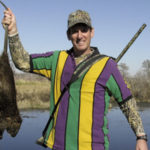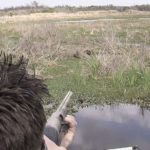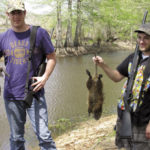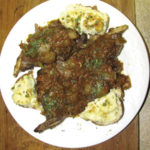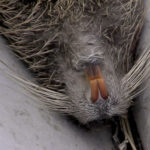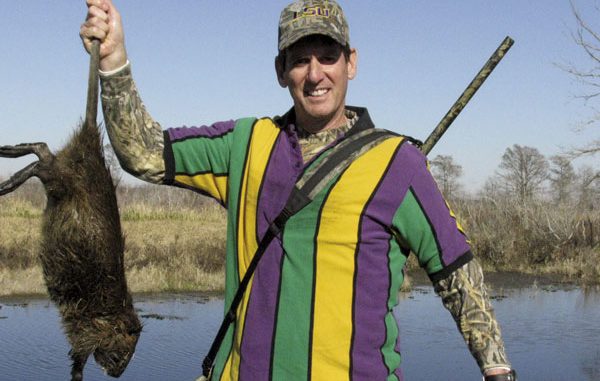
Ready for some actual hunting? Then hit the marsh levees, and load up on fun-to-hunt and delicious nutria.
The oysters were fat, cold and super salty — positively addictive. One little pinch and the tail meat — covered in bright-yellow fat — slipped from the shells of the big Belle River crawfish. The grilled wahoo, drenched in lemon-butter, shamed any rendition of Maine lobster. The steaming cauldron of teal, quail and andouille jambalaya was ravaged mercilessly by salivating guests scooping with huge spoons.
“WOWs!” echoed through the mass of black and gold attire. “YUMs!” from pretty puckered lips bordered by dangling earrings punctuated the olfactory and taste sensations that filled Doc’s Bourbon Street bungalow.
But the “rabbit” buffalo wings were going fastest — faster even than my button-buck fajitas.
How long could the ruse last? How long would the elegant guests remain conned? How long would all those lipsticked mouths continue slurping the meat off those “rabbit” legs Pelayo piled on the serving platter? For how much longer would those manicured fingernails daintily grasp the ends of the “rabbit” legs while stripping them of their luscious meat? How long till those pretty female cheeks, with their fleur-de-lis face-paintings, stop smiling and contort in a shrieking rage — “WE’RE EATING BIG RATS?!?”
Those brightly-painted fingernails would then rip into Pelayo’s face like the claws of a tiger!
But when?
I’d gotten a hint a few minutes earlier. The pre-Super Bowl crowds below Doc’s bungalow shamed — in both number and exuberance —those apres’ Endymion revelers we usually encountered here this time of year.
Trisha was on the balcony displaying her Saints “paint brassiere” amidst a deafening din of whoops, and with no fewer than 10 Blackberries videoing and clicking away. No telling how many were doing the same from BELOW the balcony.
I ran to Doc’s coat-closet for mine. After finally locating my jacket and rummaging through the pockets, the closet door swung most of the way closed, and I heard female voices on the outside. The “door” in Doc’s bedroom bathroom consisted of a drape featuring a montage of those Vargas paintings from the old Playboy. Not much of a barrier. So I could hear the running water, the flushing — and the female voices within. And one was clearly Trisha’s.
Made mischievous by two of Doc’s famous margaritas, I hid behind some clothes and cupped my ear. Here was a chance — at long last — to discover, perhaps, what actually goes on during those crowd visits by women to the powder room. It was irresistible.
“Did you try the nutria?” I heard Trisha ask after giggling her way through her cravings for a “Brees-Shockey sandwich.”
“What?!” came Priscilla’s shocked answer.
“Oh, sorry!” Trisha laughed. “I meant the rabbit wings,” she stressed the word “rabbit” then revealed the “wings” true identity, giggling maliciously at Pelayo’s culinary swindle. Then Trisha resumed describing her fantasy Saints sandwich recipe — which wasn’t what had shocked Priscilla.
I heard nothing more for a few seconds, waited for them to exit, then slipped back into the den. Looking over I saw Priscilla sashaying right past the main serving table toward the “oyster bar” near Pelayo. Though several of us volunteered for shucking duties, Doc had the caterers provide the shuckers. Several of his out-of-town doctor buddies were on hand, you see. So he just HAD to show off.
Taking a cue from Al Scramuzza’s crawfish boilers, Doc had his oyster shuckers duded-up in baby blue tuxedoes.
“I ain’t gonna be no looza!” the florid-faced Doc Fontaine kept blurting while pointing at his shuckers. “I’m gonna do like Al Scramuzza!”
The locals roared with mirth, while the perplexed out-of-towners twittered politely: “tee-hee-hee.”
“We’ll be blasting nutria on Artie’s duck lease around Houma,” Pelayo told Chris, who’d been too busy on the balcony and was a trifle out-of-the-loop on the weekend plans. “Coming?”
(Note: The season on WMAs ends with the rabbit season on Feb. 28. A Louisiana trappers license — $25 and available at all regular hunting- and fishing-license outlets — extends this season of uninhibited slaughter on private land until March 30.)
The fresher marshes — like the ones in lower Terrebonne, in the Salvador area, etc. — make for the best nutria hunting. By February and March most of the higher shrubs are shriveled and flat. The nutrias stick out pretty easily. We merely walk the ridges and levees (all the camaraderie of a duck blind, but with motion and exercise) shooting the bull, reminiscing (lying) about our Tiger Town conquests in amour, while looking for those little brown clumps — whereupon the stalk or the aiming commences.
In the interim, bald eagles, teal, poul-de eau, roseatte spoonbills, among other creatures, provide an entertaining panorama.
(Note: Airboats and surface-drives boats also work ideally for nutria hunting, but LDWF enforcement advises me that — despite the LDWF’s dedication to controlling these pests, which includes actually legalizing nutria night-hunting from April 1 until Oct. 1 this year for licensed participants in the special Nutria Control program — despite all this, shooting from a moving power-boat technically remains a no-no. So if the warden who checks you is in a bad mood that day, please don’t say you read it was OK in Louisiana Sportsman. There, I’m off the hook.)
“Just great,” deadpanned Priscilla’s husband Spencer as he walked toward Pelayo with a disgusted look after overhearing. “Just great. Shooting stuff just for the fun of it — just great! You guys set a fine example for our sport. You’re the guys who give PETA all the ammo against us. So go ahead. You guys go out there — and get your yahoo shootin’ jollies. Just great!”
Spencer (clad that night in a spanking-new personalized Ducks Unlimited sweater) was famous for bird “hunting” junkets to Mexico, back when it was safe. Lately it’s Argentina. He piles up doves, pigeons and ducks by the hundreds. Three shotguns are needed to keep barrels (almost literally) from melting from the constant shooting. All birds are “donated” to the hapless natives. Guides locate the flyways, set up the blinds (in a word: do all the genuine hunting). They and their families retrieve, clean, cook and eat most of the kill.
But apparently “shooting stuff just for the fun of it” plays no role in Spencer’s “hunts.”
By the time Priscilla finally spilled the beans about Pelayo’s “big rats” (which were certainly shot “for the fun of it” but also provided “fun-eating,”) nobody cared — thanks to Doc’s famous Pete’s Specials.
We were walking the (semi) firm marsh (watch those flotants!) below Gibson when Artie’s nephew Tommy, 13, suddenly hunkered down and his face lit up. Cats get this look too, when eyeing that cardinal at the bird feeder. He looked over and smiled wickedly. His cousin Kyle returned the look. They were in rapture. Two predators closing on prey. Nothing gets the predatory juices flowing like stalking.
After a couple trips these youngins had started running up their noses at deer hunting invites. But at this one — recalling the previous year’s shoot-em-up nutria trip — their eyes lit up. Now, again, they were in their favorite role, the one nature designed them for — hunters, predators. All traditional definitions of hunting include: movement, action, stalking, killing — all fan this fire of predatory thrills.
So I search classical literature in utter vain for a definition of hunting that reads thusly: “fighting to stay awake and to keep circulation in your buttocks, while sitting utterly immobile for many hours scanning ugly monotonous terrain in the overwhelmingly vain hope that an essentially nocturnal prey animal will show itself for a few brief moments during daylight hours. Then secretly rejoicing when the butt-numbing and near-lobotomizing vigil finally ends so one can scoot back to camp to booze it up with buddies and, at long last, actually enjoy oneself.”
Closing on unsuspecting prey is what really lights the predatory fire. The glow was all over Kyle and Tommy’s faces. And it was contagious. Pelayo, Chris and I were catching it — shades of our own (genuine!) “youth hunts!” Not sitting in some blind or stand — but roaming and blasting, roaming and blasting. Then going home and watching “The Rat Patrol” on Tuesday nights and “Morgus The Magnificent” on Sahhh-dy nights. Sweet memories indeed!
We hung back watching the kids as they closed the distance on a group of three rats soaking up the midday sun at the base of the spoil bank. The boys crouched lower, lower, almost on hands and knees now, and taking advantage of a little clump of wax myrtles for cover as they closed the distance to their hapless, unsuspecting prey.
“Hunting is not a human fact; it is a zoological fact,” tells us Jose Ortega Y Gasset in his classic Meditations on Hunting. “It is an imitation of the animal, in that mystical union with the beast the hunter begins to behave like the game.
“He will instinctively shrink from being seen, he will avoid all noise, he will perceive all his surroundings from the point of view of the animal.”
Indeed, Jose! Here we had the spectacle with bells on. The boys worked as a team, Tommy with his scoped .22 and Kyle with his 20-gauge pump (steel shot required). They were about 30 yards out when Tommy kneeled and took aim. Kyle stood at the ready behind him.
“Come on!” Pelayo hissed. “Shoot!”
But Tommy, unlike his uncle Artie, is a meticulous young chap. He was making sure. He insists on head shots. Finally — POP! And one hutria keeled over, his legs twitching in the air. The other two bolted off, and that’s when Kyle sprung into action, running up a few feet over the flotant, raising the shotgun — BLAM! Shaw-uck went the little pump — BLAM!! Nutria flipped. And BLAM! The third nutria slowed down as the shot raked his back.
POP! Tommy finished him off with a bullet through the boiler room. Now they were running over, stumbling in their hip-boots.
“ALRIGHT!” Tommy hoisted his prey by the tail and looked back. Kyle reached his and hoisted it too, smiling from ear to ear. They were ecstatic. Here was hunting to wrench a kid from the most action-packed video game!
Ten minutes later, they jumped two more from a patch of elephant ears near the shore of a pond. The nutrias immediately hit the water and dove.
“Let’s wait a bit guys,” I suggested. “Those nutrias might come back.”
And we sat on a log for drinks, sandwiches and chips.
In about five minutes, Kyle pointed. “Hey! Is that…?”
Sure was. They’d popped up about 80 yards from shore and were starting to swim back. We hunkered down again in the surrounding bushes. In they came … in … closer … closer. I looked over and had to stifle a laugh. Those faces again — those alert, excited predator faces. In three minutes the, nutrias had swum in to about 20 yards from shore. POP! Tommy picked one off.
BLAM! — BLAM! Pelayo and Chris now opened up.
“Why let the kids have all the fun?” Pelayo whooped as he worked his bolt. Both nutrias were now floating, lifeless.
Over in more brackish marshes, the hunting’s a bit more difficult since the nutrias hide out in the standing wire and cord grass. You can walk them up, but they’ll scurry through those tunnels, and it’s hard to get a clear shot. They rarely run through a clearing. In such places it’s easier to hunt from a boat, a pirogue especially, and catch them as they swim around during early morning and late evening.
The deer went nocturnal before Christmas. The ducks and geese got hip to the permanent blind and decoys around the same time. You’ve barely smelt any powder in two months. Your predatory instincts have numbed and crave stimulation.
Well, March is here, and it’s finally time to start hunting! Time to finally burn some powder. To get our shootin’ jollies. Then to lavish the serving tables at our wild game parties with some serious “slap-yo-mama!” vittles.
In fact, Louisiana is hardly the only place in North America inhabited by nutria. A study in 1974 by the University of Nebraska revealed that nutria breeding populations existed in 20 U.S. states and three Canadian provinces. Between 1930 and 1950, Oregon had 600 nutria farms! In 1955 a pair of “purebred” nutria were sold at auction to an Oregon fur farmer for $1,550!
They got out there too. And a decade later, strychnine was the solution recommended by Oregon wildlife officials to remedy the state’s nutria infestation and its resultant crop and timber damage.
It’s interesting that McIllhenney imported his nutrias to Avery Island because the beasts were in danger of extinction in South America early in this century. Seems that old Ed was an environmentalist before environmentalism was cool.
Europe (Germany in particular) had a hearty appetite for nutria hides and meat back then. Seventy years ago, nutria farms were touted by hucksters as a sure-thing, get-rich project. Nutria farms sprouted from California to New Jersey. In fact, Mc Illhenney’s original nutrias actually came from a New Jersey farm, not Argentina.
But nutrias hate cages. They hate domestication. They’ve escaped from cages all over the world, but only in Louisiana did the creatures take major hold and proliferate … and proliferate.
And why not? Here was a place practically identical to their homeland. The climate was equally horrendous. The roads just as potholed. They opened a phone book and saw names like Romero and Segura, Nunez and Humberto. They opened the paper and read of a Caudillo named “Kingfish” who inflamed crowds from a balcony, built great monuments, kept a private army then died in a hail of gunfire “with his boots on,” as the saying went in the old country.
The nutrias grew positively misty eyed with memories of home. There was a carnival season. Many people went home for a siesta.
“Home!” it wailed. “Home at last!” and it settled down to the important business of eating and mating.
Seems to me a creature whose main concerns in life are eating and mating found the perfect home in Louisiana.
